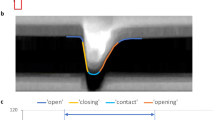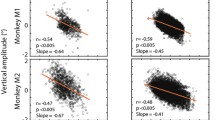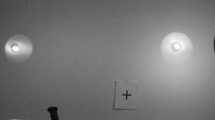Abstract
It is known that TMS can induce blinking, but it is unknown to what extent and at what time TMS-induced blinking can cover the pupil. We applied single-pulse TMS with a leftward and rightward monophasic current through a round coil over the occipital pole in 8 healthy subjects, using high-speed video to monitor left or right eye with a spatial resolution of 0.1 mm and a temporal resolution of 2 ms. We plotted eyelid position relative to upper and lower pupil borders as a function of time after TMS for each subject and current direction. We found 2 blinks in every subject, an isolated late blink with one current direction and a superimposed early and late blink with the other current direction, in accordance with our previously reported association between a leftward and rightward lower coil rim current and an early blink in right and left eye, respectively. Blink extent varied, but 4 subjects showed total pupil covering with both current directions. Blink timing varied, but pupil covering was initiated as early as 32 ms after TMS and pupil uncovering was completed as late as 200 ms after TMS. We found no saccades. We conclude that TMS can cause an important optical disruption of visual perception.

Similar content being viewed by others
References
Amassian VE, Cracco RQ, Maccabee PJ, Cracco JB, Rudell A, Eberle L (1989) Suppression of vision by magnetic coil stimulation of human occipital cortex. Electroencephalogr Clin Neurophysiol 74:458–462
Amassian VE, Cracco RQ, Maccabee PJ, Cracco JB, Rudell AP, Eberle L (1998) Transcranial magnetic stimulation in study of the visual pathway. J Clin Neurophysiol 15:288–304
Ando K, Kripke DF (1996) Light attenuation by the human eyelid. Biol Psychiatry 39:22–25
Arrigg P, Miller D (1985) A new lid sign in seventh nerve palsy. Ann Ophthalmol 17:43–45
Barker AT, Jalinous R, Freston IL (1985) Non-invasive magnetic stimulation of human motor cortex. Lancet 8437:1106–1107
Beckers G, Hömberg V (1991) Impairment of vision and visual short term memory scanning by transcranial magnetic stimulation of occipital cortex. Exp Brain Res 87:421–432
Beckers G, Zeki S (1995) The consequences of inactivating areas V1 and V5 on visual motion perception. Brain 118:49–60
Casse G, Sauvage JP, Adenis JP, Robert PY (2007) Videonystagmography to assess blinking. Graefes Arch Clin Exp Ophthalmol 245:1789–1796
Cocito D, De Mattei M (1992) Inadequacy of transcranial magnetic stimulation in the neurophysiologic assessment of Bell’s palsy. Electromyogr Clin Neurophysiol 32:521–530
Collewijn H, van der Steen J, Steinman RM (1985) Human eye movements associated with blinks and prolonged eyelid closure. J Neurophysiol 54:11–27
Corthout E, Uttl B, Ziemann U, Cowey A, Hallett M (1999a) Two periods of processing in the (circum) striate visual cortex as revealed by transcranial magnetic stimulation. Neuropsychologia 37:137–145
Corthout E, Uttl B, Walsh V, Hallett M, Cowey A (1999b) Timing of activity in early visual cortex as revealed by transcranial magnetic stimulation. Neuroreport 10:2631–2634
Corthout E, Uttl B, Juan CH, Hallett M, Cowey A (2000) Suppression of vision by transcranial magnetic stimulation: a third mechanism. Neuroreport 11:2345–2349
Corthout E, Barker AT, Cowey A (2001) Transcranial magnetic stimulation. Which part of the current waveform causes the stimulation? Exp Brain Res 141:128–132
Corthout E, Hallett M, Cowey A (2003) Interference with vision by TMS over the occipital pole: a fourth period. Neuroreport 14:651–655
Corthout E, Hallett M, Cowey A (2007) TMS-induced scotomata: time-based neglect. Clin Neurophysiol 118:1895–1898
Cowey A (2005) The Ferrier lecture 2004 what can transcranial magnetic stimulation tell us about how the brain works? Philos Trans R Soc Lond B Biol Sci 360:1185–1205
Doane MG (1980a) Interactions of eyelids and tears in corneal wetting and the dynamics of the normal human eyeblink. Am J Ophthalmol 89:507–516
Doane MG (1980b) Dynamics of the human blink. Ber Zusammenkunft Dtsch Ophthalmol Ges 77:13–17
Evinger C, Shaw MD, Peck CK, Manning KA, Baker R (1984) Blinking and associated eye movements in humans, guinea pigs, and rabbits. J Neurophysiol 52:323–339
Frueh BR, Hassan AS, Musch DC (2005) Horizontal eyelid movement on eyelid closure. Ophthal Plast Reconstr Surg 21:109–111
Ghezzi A, Callea L, Zaffaroni M, Zibetti A (1992) Motor potentials of inferior orbicularis oculi muscle to transcranial magnetic stimulation. Comparison with responses to electrical peripheral stimulation of facial nerve. Electroencephalogr Clin Neurophysiol 85:248–252
Hallett M (2007) Transcranial magnetic stimulation: a primer. Neuron 55:187–199
Kennard DW, Glaser GH (1964) An analysis of eyelid movements. J Nerv Ment Dis 139:31–48
Maccabee PJ, Amassian VE, Cracco RQ, Cracco JB, Anziska BJ (1988) Intracranial stimulation of facial nerve in humans with the magnetic coil. Electroencephalogr Clin Neurophysiol 70:350–354
Macdonald EA, Maurice DM (1991) The kinetics of tear fluid under the lower lid. Exp Eye Res 53:421–425
Meyer BU, Diehl R, Steinmetz H, Britton TC, Benecke R (1991) Magnetic stimuli applied over motor and visual cortex: influence of coil position and field polarity on motor responses, phosphenes, and eye movements. Electroencephalogr Clin Neurophysiol Suppl 43:121–134
Moseley MJ, Bayliss SC, Fielder AR (1988) Light transmission through the human eyelid: in vivo measurement. Ophthalmic Physiol Opt 8:229–230
Riggs LA, Volkmann FC, Moore RK (1981) Suppression of the blackout due to blinks. Vision Res 21:1075–1079
Robinson J, Bayliss SC, Fielder AR (1991) Transmission of light across the adult and neonatal eyelid in vivo. Vision Res 31:1837–1840
Shore JW (1985) Changes in lower eyelid resting position, movement, and tone with age. Am J Ophthalmol 99:415–423
VanderWerf F, Brassinga P, Reits D, Aramideh M, Ongerboer de Visser B (2003) Eyelid movements: behavioral studies of blinking in humans under different stimulus conditions. J Neurophysiol 89:2784–2796
Volkmann FC, Riggs LA, Moore RK (1980) Eyeblinks and visual suppression. Science 207:900–902
Zhu H, Chauhan A (2007) A mathematical model of tear mixing under the lower lid. Curr Eye Res 32:1023–1035
Acknowledgments
This work was supported by Medical Research Council Programme Grant G7103979 to Alan Cowey. The Kodak Ektapro EM was borrowed from the EPSRC Engineering Instrument Pool in 2000, which was then managed and run by the CLRC Rutherford Appleton Laboratory.
Conflict of interest
The authors declare that they have no conflict of interest.
Author information
Authors and Affiliations
Corresponding author
Electronic supplementary material
Below is the link to the electronic supplementary material.
Rights and permissions
About this article
Cite this article
Corthout, E., Hallett, M. & Cowey, A. TMS-induced blinking assessed with high-speed video: optical disruption of visual perception. Exp Brain Res 210, 243–250 (2011). https://doi.org/10.1007/s00221-011-2626-y
Received:
Accepted:
Published:
Issue Date:
DOI: https://doi.org/10.1007/s00221-011-2626-y




